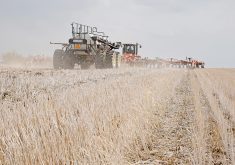Many producers dread the year-end deadline.
They dread the requests from their accountants asking for records because it might mean spending the entire weekend or longer locked in the home office trying to catch up the books.
With a few tips and tricks, this process can be less daunting and costly.
Here, we will identify three time-saving techniques to organize your records more effectively, ultimately reducing your time spent and the accounting fees for future years.
Digitalization of records
Read Also

Trump’s trade policies take their toll on Canadian producers
U.S. trade policy as dictated by president Donald Trump is hurting Canadian farmers in a multitude of ways.
Implementing a digitized document retention system can potentially be a major time and money saver for a small business. An efficient scanner can be one of the greatest tools in your bookkeeping arsenal that will pay for itself in the savings from just the paper, ink, and staples for a single year.
By scanning copies of your paperwork, as data is input, you create an organized, easily accessible system that will improve efficiencies and save time. Now, when that letter comes from the accountant or a review from Canada Revenue Agency, documents can be produced with a click of a button.
Money in the details
Time is money when you are a producer. Spending an extra 15 seconds per entry to input memo notes on entries and split out the detail lines of an invoice can save significant time later.
Many people skip the details on entries and enter multiple line items into one line as a lump sum.
This can have considerable impacts. It can cause entries to be classified incorrectly requiring adjustments, create confusion that requires follow-up discussions, and increase the time required to prepare the year-end. Inputting valuable details can provide information to improve efficiencies in compiling the year-end, which can prevent increased costs. Examples may include quantities, equipment and descriptions of items bought or sold.
Irregular entries
For unusual transactions (government assistance, unusual payments made or received) it can be beneficial to create a special account. It is quicker for a tax preparer to assess the items from a single account, rather than having to identify unusual entries buried in other accounts during reconciliations.
There is an added benefit of streamlining these entries, reducing the likelihood of errors created and ultimately saving the company costs.
These are just three tips — there are many more.
Most software programs allow for the direct importing of your statements, recognizing common transactions, and batch inputs for large volumes of entries. A person can cut down processing times significantly. Some programs will even allow you to print copies of invoices directly to their document retention folder, eliminating the need to print them.
If the thought of digitizing your bookkeeping records seems overwhelming and you require assistance, contact your accountant’s office.
An afternoon working with the right person can help to ensure your records are set up correctly, that you understand the annual adjustments, and that new accounts are set up correctly. This reduces redundancies and improves efficiencies, resulting in cost-savings for personnel, accounting fees, office supplies, as well as improved knowledge and control of the bookkeeping process.
These cost and time savings will compound every year of operation.
Colin Miller is a chartered accountant and partner with KPMG’s tax practice in Lethbridge. Contact: colinmiller@kpmg.ca.















